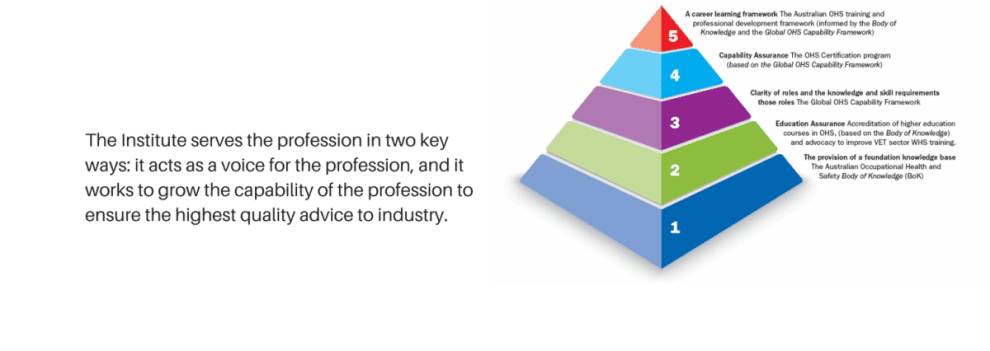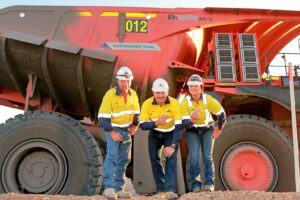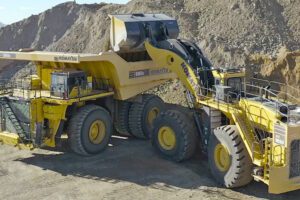Health and Safety Certification programs have been running for 30 years in the UK, USA and Canada. Safety Institute of Australia CEO David Clarke describes how the Institute is now certifying health and safety practitioners and professionals, creating a standard of practice which is being recognised both in Australia and globally.
In 2011, the global heads of health and safety for some 30 mining companies met with INSHPO (the International Network of Safety & Health Practitioner Organisations, a global alliance dedicated to advancing the occupational safety and health profession) to discuss the possibility of setting a common standard and bar for OHS professionals around the world.
This set in motion what is one of the most important developments in health and safety globally: the OHS Professional Capability Framework: A Global Framework for Practice.
Mr Clarke explained that the framework was developed from an international analysis of data from national professional associations and certification bodies. “Given the diversity of OHS approaches across countries, INSHPO created an overarching structure designed to encompass all of them. The framework was analysed by safety experts from a variety of industries around the world, and was enhanced through practical application by the International Council on Mining and Metals” he said.
The framework was launched last September in Singapore and adopted by organisations from more than 20 countries under the Singapore Accord, establishing critical benchmarks and defining the skills and knowledge requirements for OHS work so that companies know what they should be getting from their OHS workforces at each of six levels of work.
Certification: Building on the Global Capability Framework
Using the knowledge and skill requirements within the Global Capability Framework as a baseline, the Institute has created an international standard certification program with three levels – Practitioner, Professional and Chartered Professional. Like most Professional Certifications, each level has minimum education and experience entry points, which is followed by an assessment process designed to demonstrate that the candidate has been able to combine their education and experience and demonstrate the ability to apply their knowledge in real world situations.
Mr Clarke explained that the work on Global Capability Framework and Certification programs is part of a wider agenda. “Together with our work on building the OHS Body of Knowledge, accreditation of higher education and our new work on professional development, we are accelerating the process of better defining helath and safety roles, and giving companies much greater confidence that the people they employ have the capability to do the work at the level employed,” he said.
Having run for 24 months now, the program has certified some 1500 early-adopter OHS Practitioner, OHS Professional and Chartered OHS Professionals. “We still have a significant journey to raise awareness and demand for certified people, but that’s an outstanding beginning,” said Mr Clarke. “Job vacancies are beginning to appear asking for certified people, and our task now is to get out to Australian businesses and accelerate that process,” he said.
The certification process
Certification assessment is different for each level of certification applied for and may involve the writing of practice reports, the undertaking of online exams and case studies, provision of referees, and in some cases, interviews by qualified capability assessors, who
hold health and safety certifications as well as senior health and safety roles in industry.
Mr Clarke also explained that the program’s educational entry points have recently been adjusted for highly experienced health and safety people. “We know that a number of people developed their careers in a different educational landscape and so may have extensive experience and capability at OHS professional level, but not necessarily university level OHS qualifications. This group has access to a special Professional Knowledge Assessment process. We’re also looking at avenues for the other two levels of Certification – Practitioners and Chartered Professional, as well as Australian law assessments for overseas applicants,” said Mr Clarke.
Mentoring and CPD
Certification is not just about an application and assessment. Certified OHS Practitioners and Professionals undertake continuing professional development (CPD) to retain their certification. This combination provides the underpinning framework to maintain and raise the standards and capability of people working within the health and safety profession.
Mr Clarke urged people who are committed to a career in the field to consider becoming certified, and invited employers wanting greater confidence in their health and safety people to promote and expect certification. “The profession has now got a clear direction and a development framework to build the capability of health and safety people and their position within the company,” said Mr Clarke. “Everyone in the field now has their chance to be a part of that direction.”
Going international with certification
Since the introduction of the program, it has continued to gather momentum and strength with those working in health and safety and across industry. “We have begun to receive applications not just within Australia but also overseas, demonstrating a widening international recognition of Australian OHS certification,” said Clarke. “There is also interest from certification bodies internationally looking at how the Program is structured and we are in separate discussions with different agencies about reciprocal recognition, most recently signing a mutual recognition MOU with our Canadian counterparts earlier this month.”
For more information visit www.sia.org.au/certification














Add Comment